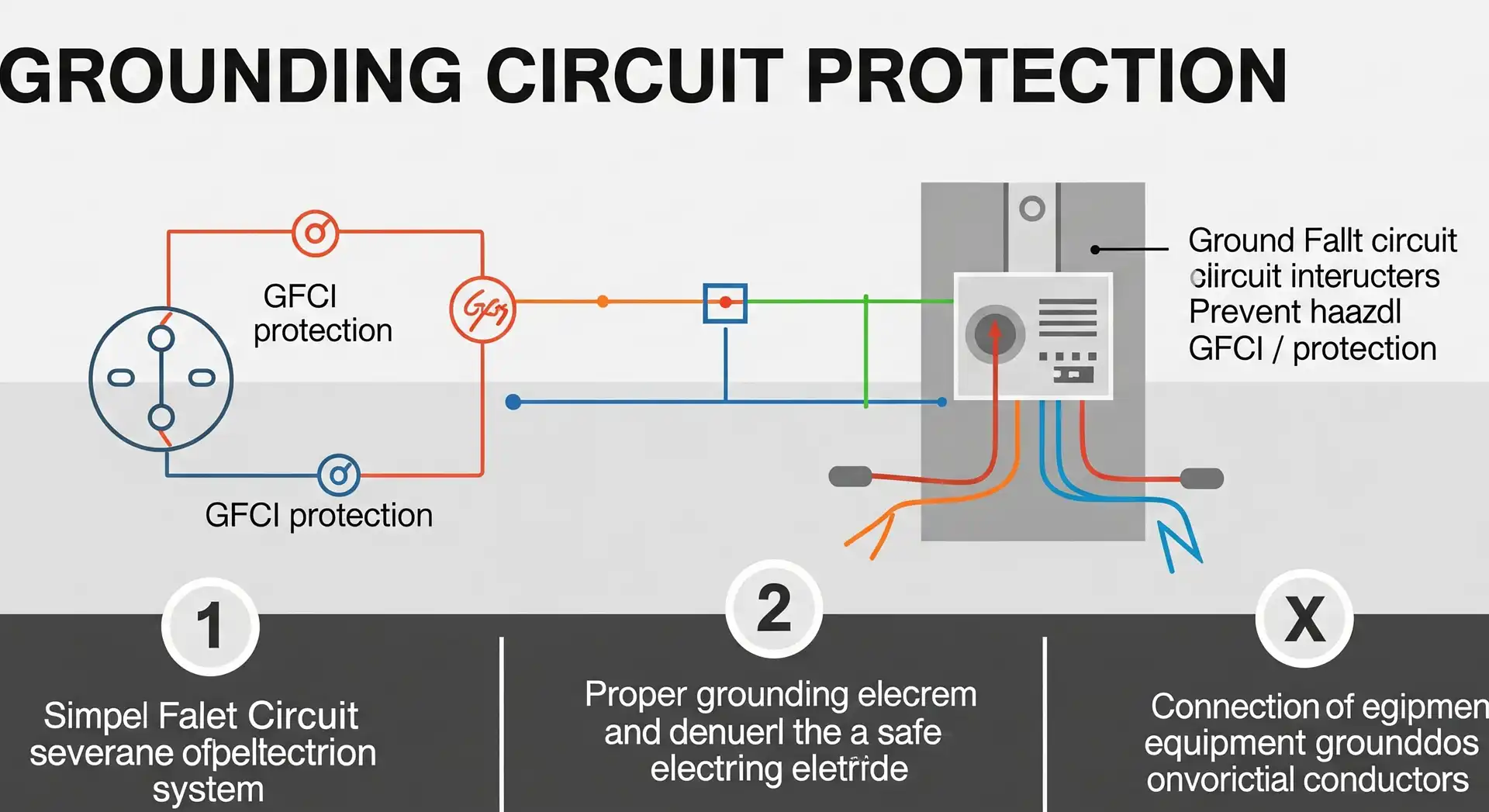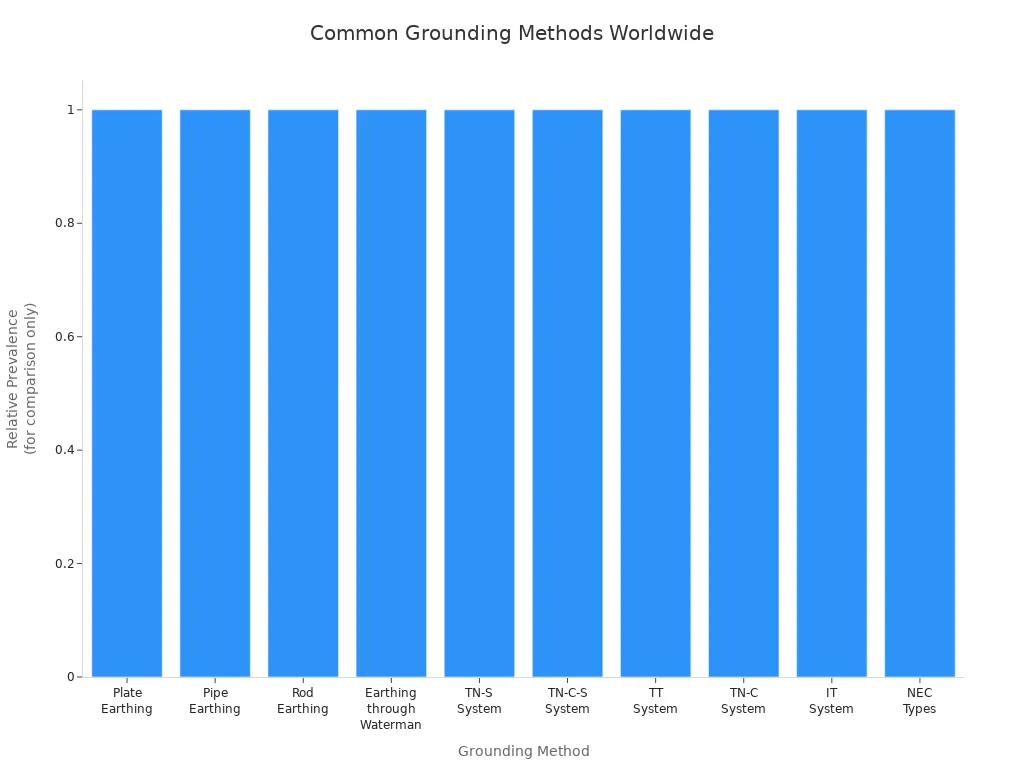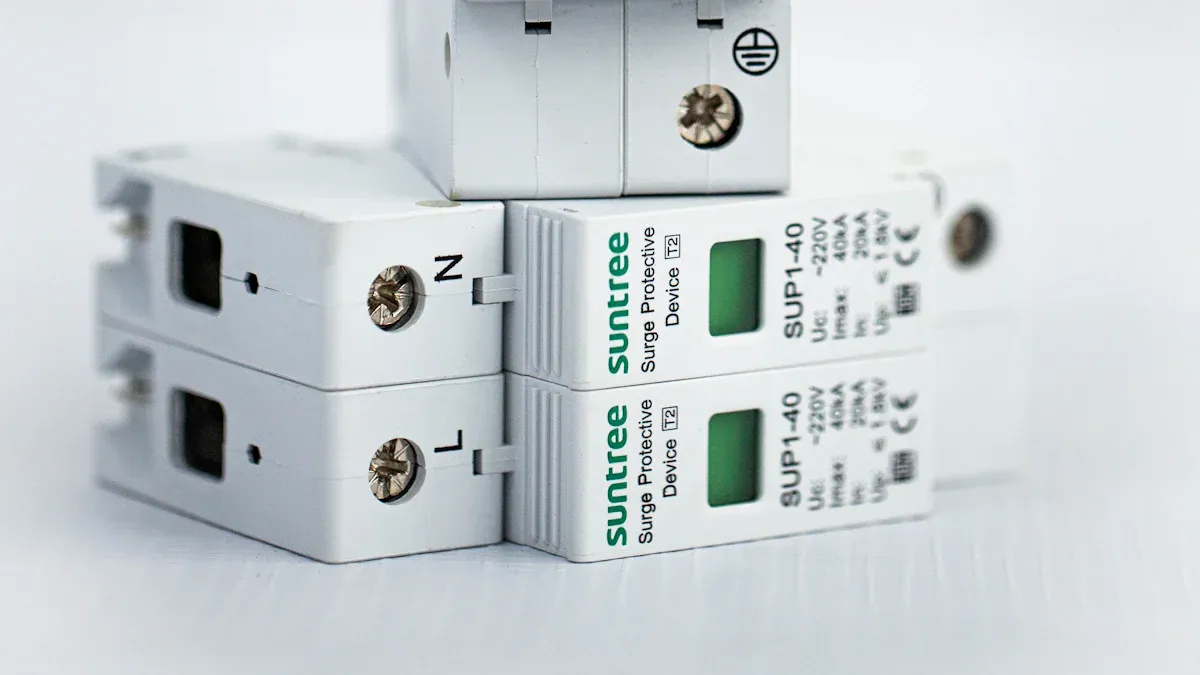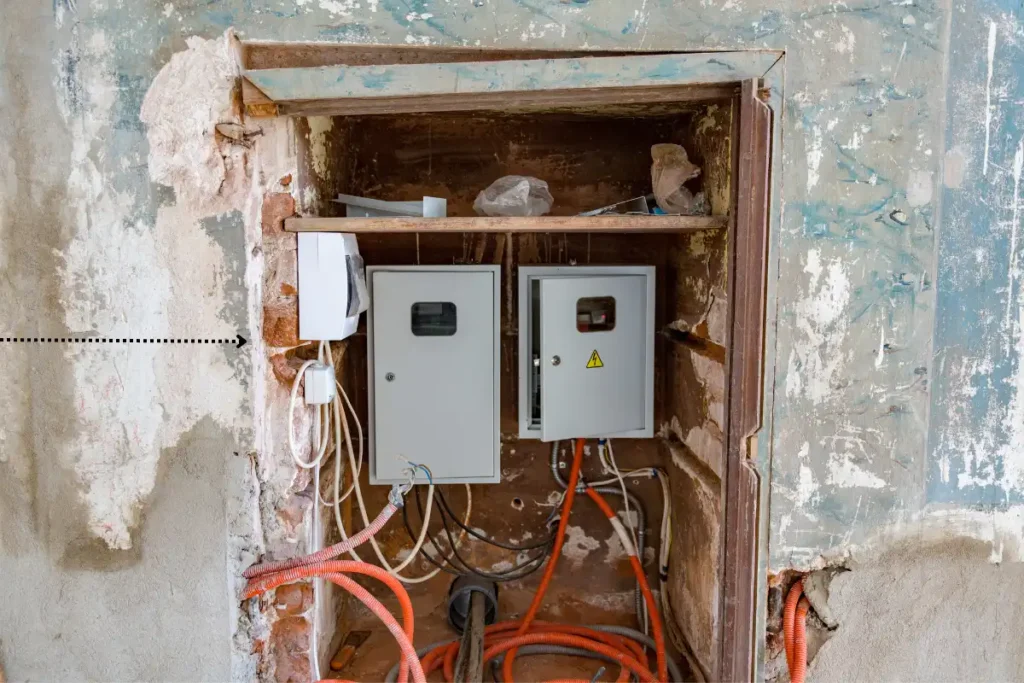Grounding protection and surge protection help stop surprise shocks. They keep people safe. Imagine a lightning storm outside. Thunder is loud and lights flicker. In this time, these systems are like quiet heroes.
- Grounding systems move extra electricity into the earth. This stops dangerous shocks and damage.
- Surge protection devices take in or send away sudden voltage spikes. They protect electronics from getting hurt.
Many homes and businesses have risks without these protections. People should ask if their electrical system really keeps them safe.
Key Takeaways
- Grounding protection moves extra electricity into the ground. This helps stop shocks and fires from happening. Surge protection stops sudden jumps in voltage. This keeps electronics and appliances safe. Grounding and surge protection need to work together for safety. Checking and fixing them often keeps them working well. A licensed electrician should install them to avoid mistakes and save money.
Grounding Protection Basics

What Is Grounding?
Grounding connects electrical parts straight to the earth. This is done with a metal rod, plate, or other conductor in the ground. The National Electrical Code (NEC) says “ground” means the earth. A grounding electrode, like a rod or plate, makes a direct path to the earth. All grounding electrodes in a building must be joined together. This forms a grounding electrode system. The system keeps people and property safe by holding equipment at a safe voltage. Grounding also keeps voltage steady and helps stop electric shocks.
Note: Grounding and bonding are not the same. Grounding links to the earth. Bonding joins metal parts so they stay at the same voltage.
How Grounding Works
Grounding gives stray or extra electricity a safe path. If a fault happens, like a broken wire or live wire touching metal, grounding sends the dangerous current into the earth. This keeps metal parts from getting charged and causing shocks or fires. Circuit breakers or fuses work with grounding. If a fault sends current to ground, these devices trip and stop power. This fast action keeps people and equipment safe.
- Grounding keeps voltage at safe levels.
- Equipment grounding links metal parts to earth to lower shock risk.
- Bonding makes sure all metal parts have the same voltage.
- Static grounding stops static electricity from building up.
- Lightning protection grounding sends lightning safely to the ground.
Common Grounding Methods
Electricians use different grounding methods in homes and businesses. The method depends on soil, building design, and local rules.
| Grounding Method | Description | Typical Usage / Region | Key Details / Standards Referenced |
|---|---|---|---|
| Plate Earthing | Copper or iron plate buried underground | Worldwide | Plate size ~60cm×60cm; buried >3m deep |
| Pipe Earthing | Steel pipe placed vertically in wet soil | Most common globally | Pipe diameter ~40mm; length 2.75m–4.75m |
| Rod Earthing | Copper or steel rod buried upright | Residential and commercial | Rod diameter ~12.5–25mm; length >2.5m |
| Earthing through Waterman | Iron pipes with clamps to lower resistance | Various installations | Needs resistance checks and good clamps |
| TN-S, TN-C-S, TT, TN-C, IT | Different ways to connect earth and neutral wires | Europe, Commonwealth, IEC/BS standards | Each system has its own wiring and safety features |
| NEC Grounding Types | Grounded, ungrounded, impedance grounded, DC grounding, and more | North America (NEC Article 250) | Covers all voltage levels and special equipment |

Electricians in North America often use green or bare copper wires for grounding. In Europe, green/yellow striped wires show protective earth connections. Using more than one electrode can lower resistance and make things safer.
Surge Protection Essentials

What Is Surge Protection?
Surge protection keeps electrical systems and devices safe from sudden voltage jumps. These jumps, called surges, can happen because of lightning, power changes, or big machines turning on or off. Surge protection devices, or SPDs, stop too much voltage from reaching equipment. They take in, block, or send away extra energy so electronics stay safe. Surge protection helps homes, businesses, and factories avoid expensive fixes and lost time.
| Function Aspect | Description | Key Advantages / Purpose |
|---|---|---|
| Primary Function | Stops damage to electrical equipment and systems from surge voltages like lightning or switching | Keeps voltage safe by taking in, sending away, or blocking extra surge energy |
| Protection Scope | Power places, communication gear, computers, and sensitive devices | Guards against high voltage, making sure systems and equipment last longer |
| Surge Components | Metal Oxide Varistors (MOV), Gas Discharge Tubes (GDT), Spark Gaps | React fast to surges, send energy to ground, block quick overvoltages |
| Multi-level Protection | SPDs at main entry, panels, and end equipment | Layers of defense against outside and inside surges, lowering damage and lost time |
Surge protection is very important for data centers, factories, and homes with sensitive electronics. It makes things work better and stops data from being lost.
How Surge Protection Works
Surge protection devices do nothing when voltage is normal. When a surge comes, the device senses the high voltage. Inside, parts like MOVs or GDTs react very fast. MOVs take in extra energy and send the surge to the ground wire. GDTs stay off during normal times but turn on during a surge, moving extra current away safely. The device goes back to normal when voltage drops. This quick action, in microseconds, keeps equipment safe from harm.
Surge protectors act almost right away when voltage spikes, stopping surges before they hurt electronics.
Types of Surge Protectors
There are different surge protectors, and each has a special job:
- Type 1 Surge Protectors: Go at the main power line. They handle big surges from lightning or power lines. People use them in stormy places.
- Type 2 Surge Protectors: Go in breaker panels. They stop surges from inside, like when big machines turn on. These are good for computers and home theaters.
- Type 3 Surge Protectors: Plug into outlets or are power strips. They protect one device from leftover surges.
- Portable Surge Protectors: Small and easy to move. People use them for laptops and phones when traveling.
- Industrial Surge Protectors: Made for factories and big machines. They stop surges that could hurt large equipment.
Tip: Using more than one kind of surge protector gives the best safety from both big and small surges.
Grounding Protection and Surge Protection Together
Why Both Are Needed
Electrical safety needs more than one kind of protection. Grounding protection and surge protection do different jobs. Grounding protection keeps people safe from shocks by sending stray current into the earth. Surge protection keeps electronics and appliances safe from sudden voltage spikes. These spikes can cause fires or break equipment.
Many things can hurt electrical systems. Lightning, power grid changes, big appliances turning on or off, and bad wiring can all cause dangerous surges. Surge protectors act like shields. They sense extra voltage and quickly send it to the ground. This stops damage before it happens. Whole-house surge protectors go in the main panel. They block surges from getting into home wiring.
A surge protector needs a good grounding system to work. It must have a safe path to send away extra energy. If grounding is bad or missing, the surge protector cannot protect electronics or stop fire risks. The 2020 National Electrical Code says new and fixed-up homes must have surge protection. This rule shows both systems are needed for safety today.
GFCIs and surge protectors fix different problems. GFCIs stop shocks, especially in wet places like kitchens and bathrooms. Surge protectors lower fire risks and stop equipment from breaking. Used together, they make a strong safety net for people and property.
How They Work as a Team
Grounding protection and surge protection work best together. Each one does what the other cannot do. Grounding protection sends fault currents safely into the earth. Surge protection takes in and sends away voltage spikes, moving extra energy to the ground.
| System | Function | Role in Protection |
|---|---|---|
| Grounding System | Sends fault currents safely into the earth to keep people and equipment safe | Cannot stop voltage surges on devices |
| Surge Protective Device | Takes in and sends away surge currents by blocking overvoltage spikes and moving extra energy to ground | Keeps electrical and electronic devices safe from harm |
A good grounding system gives surge protectors a safe path for extra electricity. Surge protectors use special parts, like Metal Oxide Varistors (MOVs), to sense voltage spikes. When a surge happens, the MOV changes how it works and sends extra energy into the ground. Without grounding, the surge protector cannot do its job. Working together, they stop shocks, fires, and equipment loss.
Real events show why both systems matter. In Orange County, Florida, emergency sites lost lots of equipment because grounding was bad. Lightning strikes caused many failures and blackouts. The main problem was high resistance in the grounding system and poor setup. Even with surge protection, bad grounding caused big losses and safety problems.
Surge protectors need to be checked often. They wear out as they take in surges. If not replaced, they can stop working and leave systems open to harm. Loose or rusty wires can make grounding worse, so surge protection does not work as well.
Tip: Always make sure both grounding and surge protection are set up and checked. This teamwork keeps homes, businesses, and people safe from surprise shocks and costly damage.
Ensuring Effective Protection
Checking Your Grounding
Homeowners and business owners can do some simple checks. They can use an outlet tester to see if outlets are grounded. People should look at the wiring, especially in old buildings. This helps find missing or old grounding. Always turn off the main breaker before checking anything. Wear safety gear to stay safe. Open the electrical panel and look for grounding wires. These wires should connect to rods or plates outside. It is smart to ask a licensed electrician for a full check and report.
Professionals use special tests to check grounding better. They might use a slab ufer continuity test or a fall of potential test. These tests measure how well the ground works. The National Electrical Code says ground resistance should be 25 ohms or less. If it is higher, adding more ground rods can help. A grounding bus bar connects all grounding wires to one spot. This lowers resistance and makes things safer.
Tip: Always write down inspection dates and test results. This helps you see if things stay safe over time.
Installing Surge Protectors
A certified electrician should do a risk check before installing surge protectors. They pick the right type and best place for each one. Type 1 surge protectors go at the main panel. Type 2 protectors go at sub-panels. Type 3 protectors go near important equipment. All surge protectors should have UL certification. Do not try to install them yourself. Mistakes can make them not work right. After putting them in, test the system to make sure it works. Never plug too many things into surge strips. Do not connect surge strips together.
| Best Practice | Why It Matters |
|---|---|
| Use a certified electrician | Makes sure installation is safe and follows rules |
| Place SPDs in layers | Stops both outside and inside surges |
| Regular inspections | Finds problems early |
Maintenance Tips
Check grounding and surge protection every year. Look for broken wires, loose clamps, or rust. Check again after storms or electrical work. Keep grounding wires short and straight. This helps lower resistance. Connect all metal parts to the same ground point. This stops voltage differences. Use the right size wire for every connection. Always follow NEC, IEEE, and UL rules for best safety.
Note: A good, low-resistance ground path helps surge protectors work fast and safely.
Common Mistakes
Ignoring Grounding
A lot of people forget how important grounding is. This can make things very unsafe. Some people do not know about soil resistivity. Others skip checking ground resistance after they finish the job. Sometimes, people forget to reconnect ground wires after moving equipment. Using the wrong size or length of ground wire also makes grounding weaker.
- Not knowing about soil resistivity and impedance rules.
- Not checking grounding resistance after setting it up.
- Forgetting to reconnect ground wires after fixing or moving things.
- Using ground wires that are too long or coiled up.
- Picking the wrong size for ground wires.
If you ignore grounding, fires and shocks can happen. Sensitive electronics can get ruined. Circuit breakers can get overloaded. Businesses might have to stop work. Good grounding keeps voltage steady and clears faults fast. Not following grounding rules can lead to fines or legal trouble.
A good grounding system keeps people and things safe. Homeowners should not think all outlets are grounded. It is important to check often and follow local rules.
Poor Surge Protector Setup
Mistakes when putting in surge protectors can make things unsafe. Some people use the wrong breaker size. Others let wires get too long or do not tighten them. Some do not check if the surge protector works with old panels. Many skip safety steps.
- Using a breaker that is the wrong size or type.
- Letting wires get too long or tangled.
- Not making sure connections are tight.
- Not checking if it works with old panels.
- Skipping safety steps.
- Not looking at warning lights.
- Not asking experts for help when needed.
If surge protectors are set up wrong, short circuits and fires can happen. Plugging in too many things can make it worse. Surge protectors wear out and need to be replaced. Getting help from a pro makes sure grounding and surge protection work well together to keep everyone safe.
Grounding protection and surge protection are both needed for safety. They help keep people and equipment safe from electrical dangers. Checking these systems often helps stop fires and damage.
Homeowners should have experts check their systems. They should look at grounding wires and change surge protectors when needed.
A licensed electrician can find problems and make sure everything is safe. Doing these things now keeps families, businesses, and electronics safe.Choose ONESTOP surge protection device: With over 20 years of manufacturing experience, international certification assurance, and excellent quality, we help you comprehensively improve circuit safety protection.
FAQ
What happens if a home has no grounding?
If there is no grounding, extra electricity cannot escape safely. People can get shocked. Electronics might stop working. Fires could start. Grounding helps keep everyone and everything safe in the building.
How often should surge protectors be replaced?
Electricians say to check surge protectors every year. Change them if the light goes out or after a big surge. Most work well for three to five years.
Can surge protectors work without proper grounding?
No, surge protectors need good grounding to send away extra voltage. Without grounding, they cannot keep devices safe from surges. Always check the grounding system first.
What is the difference between a power strip and a surge protector?
| Feature | Power Strip | Surge Protector |
|---|---|---|
| Main Purpose | Adds more outlets | Blocks voltage spikes |
| Safety Feature | None | Has surge protection |
A surge protector keeps electronics safe. A power strip does not.
The following information may be of interest to you
What Makes AC Better Than DC for Homes
Why Ground Wires Matter: Differences from Neutral & Bonding Wires
Panel Surge Protector Pros and Cons for Homeowners
Do you need a surge protector for your solar system
How to Replace a Surge Protector Safely and Efficiently




